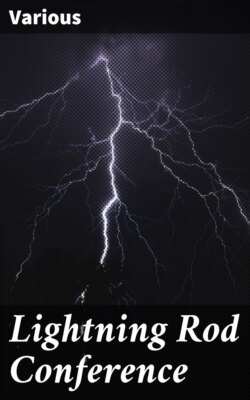Читать книгу Lightning Rod Conference - Various - Страница 13
На сайте Литреса книга снята с продажи.
REPLIES.
ОглавлениеTable of Contents
39, Wapping, London, E.
1. The upper terminals are made of a copper tube ⅝ inches in diameter and 1/16 inches thick [A. 0·11 in.] In the upper end of the tube is fitted 15 inches of copper rod tapered to a point at the top, into which is fixed 3 or more smaller rods about ¼ inch in diameter [A. 0·05 in.] each tapered to a point, and brought into the parent rod in a curve (not at an angle). The next part of the tube, down to about 9 inches from the bottom, is filled with a stiff iron rod to strengthen it, the lower end of the tube being left open to receive the rope. This constitutes what is called “the point.” These points vary in length from 2 or 3 to 8 or 10 feet when used for buildings. A square-topped tower would require a much higher point than would be necessary for the top of a spire.
Sometimes the points are tipped with platinum, which we consider to be altogether superfluous.
2. The conductor is simply a wire rope, varying in size, and mostly either ⅜,½, or ⅝ inches in diameter [A. 0·11, 0·20, or 0·31 in.] These ropes are made in two different forms: the one ⅜ inch diameter [A. 0·11 in.], most suitable for ships’ use, is composed of 49 No. 18 guage copper wires, each wire having a circumferencial measurement of ·157 inches [A. 0·002 in.]; the circumferencial or surface measurement of the whole of the 49 wires is equal to 5·693 inches [A. 0·11 in.], or say, equal to the surface of a copper band 2·846 inches wide—i.e., measuring both sides of the band.
The other make, say ½ inch diameter [A. 0·20 in.], much used for lofty buildings, is composed of 7 No. 7 guage copper wires, each wire having a circumferencial measurement of ·581 inches [A. 0·027 in.]; the circumferencial or surface measurement of the 7 wires is equal to 4·067 inches [A. 0·19 in.], or say equal to the surface of a copper band 2·033 inches wide.
3. There is no definite proportion observed between the length and sectional area of the conductor. We take it that the sectional area should be the same, irrespective of length, as we do not trace that lightning varies in intensity while passing through a conductor of greater or less length. The rather prevalent idea that a smaller conductor is sufficient for a low building is, we think, erroneous, as we do not find any data to show that lightning in its descent loses any portion of its force until it actually enters the earth.
4. The copper rope is joined to the upper terminal by passing the end of the rope into the tube at the lower end of the terminal for the space of about 9 inches, and fixing it with 3 copper rivets. There is no other join in the conductor whatever—a feature of much greater importance than is sometimes admitted.
5. The upper terminal is passed through two strong earthenware insulators which are usually fixed to the building by two strong galvanized iron staples. Other modes of fixing the terminal must sometimes be resorted to, as some factory chimneys are capped with iron, and buildings of varied forms must be treated with according to circumstances. Having fixed the terminal, the rope may then be led down the building on the most convenient side for the purpose, and fixed at intervals of 6 or 8 ft., according to circumstances, with glass insulators supported by copper brackets. The rope should be given the straightest course practicable from the upper point down to the earth, carefully avoiding all angles, specially an acute angle, as much as possible, and in its passage it should be kept clear from any other metal in the building.
There are three matters to which we would call special attention, viz.:
